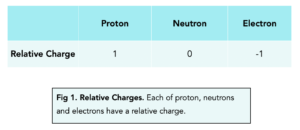Relative Electrical Charges (GCSE Chemistry)
Relative Electrical Charges
Atoms and Elements
- The nucleus contains protons (+1 charge) and neutrons (0 charge).
- Electrons (-1 charge) orbit in shells around the central nucleus.
- The mass if concentrated in the nucleus.
- The number of protons = the number of electrons in a non-charged atom.
Protons, Neutrons, Electrons
Structure of an Atom
An atom consists of neutrons, protons and electrons. Each atom has 2 regions:
- The nucleus is found in the centre of the atom, and consists of positively charged protons and uncharged neutrons. This makes the atomic nucleus positively charged.
- A cloud of electrons surrounding the nucleus. The electrons are negatively charged and orbit the nucleus in shells.
Relative Charge
- Protons, neutrons and electrons have relative charge. We can give a relative charge to protons (+1), neutrons (0) and electrons (-1). Make sure to memorise these!
- All atoms have no overall charge. Atoms are neutral and have no overall charge because the number of protons (positively charged) equals the number of electrons (negatively charged). The opposite charges cancel each other out.

Atomic Number
The atomic number is the number of protons in the nucleus. Each element has its own atomic number and specific characteristic that helps you recognise it. The periodic table is arranged in ascending atomic number.
- Atoms of the same element have the same number of protons. The number of protons in a particular atom is equal to the atomic number and all atoms of a specific element have the same number of protons. For example, calcium has an atomic number of 20. Therefore calcium has 20 protons and all atoms of calcium have the same number of protons – 20.
- Atoms of different elements have different numbers of protons. The atomic number of each element is different, therefore the number of protons each element has is different. For example, calcium has an atomic number of 20 and therefore has 20 protons. However sodium has an atomic number of 11 and therefore has 11 protons.





Still got a question? Leave a comment
Leave a comment